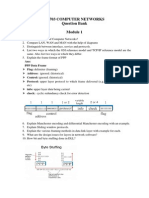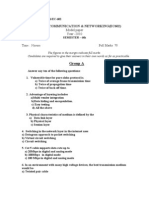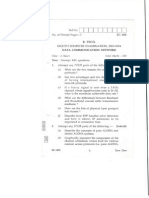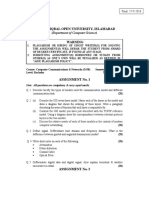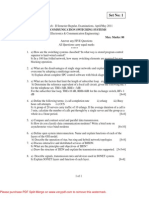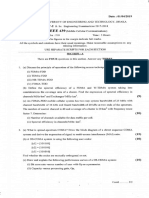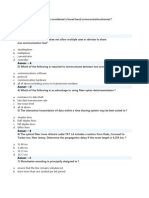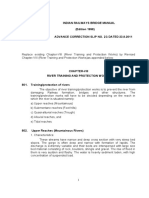ECX5234 Data Communications Assignment 1 - 2011/2012: The Open University of Sri Lanka
ECX5234 Data Communications Assignment 1 - 2011/2012: The Open University of Sri Lanka
Uploaded by
Sasith WickramasingheCopyright:
Available Formats
ECX5234 Data Communications Assignment 1 - 2011/2012: The Open University of Sri Lanka
ECX5234 Data Communications Assignment 1 - 2011/2012: The Open University of Sri Lanka
Uploaded by
Sasith WickramasingheOriginal Title
Copyright
Available Formats
Share this document
Did you find this document useful?
Is this content inappropriate?
Copyright:
Available Formats
ECX5234 Data Communications Assignment 1 - 2011/2012: The Open University of Sri Lanka
ECX5234 Data Communications Assignment 1 - 2011/2012: The Open University of Sri Lanka
Uploaded by
Sasith WickramasingheCopyright:
Available Formats
ECX5234 - Data Communications
The Open University of Sri Lanka
DEPARTMENT OF ELECTRICAL & COMPUTER ENGINEERING
ECX5234 Data Communications Assignment 1 - 2011/2012 - Due on 15/07/2011
Very Important Reduced marks are given for late submissions. Zero marks will be given for copying. Direct reproduction of course material as answers will result in reduction of marks. Clear and brief answers with no unnecessary details will gain maximum marks. Always keep contact with the course coordinator either through email, telephone or by prior appointment. For this assignment you need to find additional information from internet or Libraries in addition to the given course material. Please write the references you use.
Answer all questions. Q1. (a) Briefly explain what a layered architecture is and how it operates when a network application is used. Also give 2 advantages and 2 disadvantages of using a layered architecture. Describe the International Standards Organization (ISO) reference model for Open Systems Interconnection (OSI) giving functions, protocols and networking devices used at each layer. Use a table to present your answer. Give some advantages and disadvantages of combining the session, presentation and application layer in the internet model. Compare circuit switching, datagram packet switching and virtual circuit packet switching. Also give an application for each. Use a table to present your answer. Converting digital data into digital methods involves 3 techniques: line coding, block coding and scrambling. Briefly explain each of these techniques giving 2 commonly used coding methods for each. For the bit stream 1 1 1 0 0 0 0 1 0 1 1 1 , draw the encoded output of the following line encoding schemes (i) NRZ-I (ii) Manchester (iii) Differential Manchester (iv) MLT-3 If the NRZ-HDB3 coding method is used, show the output for the following bit stream. 1 1 0 0 0 0 1 0 0 0 0 0 1 0.
(b)
(c)
Q2.
(a)
(b)
(c)
(d)
(PTO)
ECX5234 - Data Communications
Q3.
(a)
(b)
(c) (d)
Compare and contrast Pulse Code Modulation (PCM) and Delta Modulation (DM). DM scheme is not suitable for signals with largely varying amplitudes between samples. Explain why. Suppose the frequency spectrum of a communication channel is from 3MHz to 4MHz. (i) If the signal to noise ratio of the channel is 24 dB, find the capacity of the channel. (ii) If there were no noise, how many signal levels would be needed to achieve the above bit rate? Phase Shift Keying (PSK) is widely used in telecommunications and networking. Explain the principle behind PSK, BPSK and QPSK. Draw the constellation diagram for the following: (i) ASK, with peak amplitude values of 2 and 4 (ii) BPSK, with a peak amplitude value of 3 (iii) QPSK, with a peak amplitude value of 4
Q4.
(a)
Consider a CSMA/CD network with a data rate of 10 Mbps. The maximum distance between any station pair is found to be 2500m for the correct operation of the collision detection process. Find the maximum distance if we increase the data rate to (i) 100 Mbps (ii) 1 Gbps (iii) 10 Gbps The Medium Access Control (MAC) in the 802.11 specification supports an optional access method designed to avoid the hidden terminal problem. (i) What is the hidden terminal problem that occurs in 802.11 networks? (ii) Briefly explain the MAC protocol used in 802.11 networks and how it avoids the hidden station problem. (iii) Compare this MAC protocol with the MAC protocols used in wired Ethernet. What is the hexadecimal equivalent of the following Ethernet? 01011010 00011000 01010101 10001000 00001010 00001111
(b)
(c)
Q5.
Do a survey on transmission media used for Local Area Networks based on the following aspects: (i) Type (ii) Data rate (iii) Maximum segment length (iv) Other characteristics Hint: You are expected to give above details for different types of Copper cables and optical fiber in your answer.
(PTO)
You might also like
- CMC Markets Four Principles For Trading in The Zone Oct 2022No ratings yetCMC Markets Four Principles For Trading in The Zone Oct 202216 pages
- From GSM to LTE-Advanced Pro and 5G: An Introduction to Mobile Networks and Mobile BroadbandFrom EverandFrom GSM to LTE-Advanced Pro and 5G: An Introduction to Mobile Networks and Mobile BroadbandNo ratings yet
- General Comments On Candidates' PerformanceNo ratings yetGeneral Comments On Candidates' Performance10 pages
- On-Line Examination COMP30091 One Hour University of Manchester School of Computer ScienceNo ratings yetOn-Line Examination COMP30091 One Hour University of Manchester School of Computer Science5 pages
- Data Communication Sample Tutorial& AnswerNo ratings yetData Communication Sample Tutorial& Answer14 pages
- Good Luck Note Students Can Check Their Evaluated Answer Sheets On 201/ May (Friday) From PM in B-208 and B-209No ratings yetGood Luck Note Students Can Check Their Evaluated Answer Sheets On 201/ May (Friday) From PM in B-208 and B-2091 page
- 08.703 Computer Networks Question Bank: Ans: PPP Data FrameNo ratings yet08.703 Computer Networks Question Bank: Ans: PPP Data Frame7 pages
- Data Communication and Computer Networks Set 1No ratings yetData Communication and Computer Networks Set 16 pages
- Computer Communication & Networking (Ec602) : Group ANo ratings yetComputer Communication & Networking (Ec602) : Group A3 pages
- CS-68 Bachelor in Computer Applications Term-End Examination June, 2012 Cs-68: Computer NetworksNo ratings yetCS-68 Bachelor in Computer Applications Term-End Examination June, 2012 Cs-68: Computer Networks2 pages
- Allama Iqbal Open University, Islamabad Warning: (Department of Computer Science)No ratings yetAllama Iqbal Open University, Islamabad Warning: (Department of Computer Science)3 pages
- Examiners' Report Computer Networks: The Bcs Professional Examination Diploma April 2005No ratings yetExaminers' Report Computer Networks: The Bcs Professional Examination Diploma April 200511 pages
- Ec2352 Computer Networks Anna University Previous Year Question Paper100% (1)Ec2352 Computer Networks Anna University Previous Year Question Paper2 pages
- Question Papers of Computer Communication Networks100% (2)Question Papers of Computer Communication Networks32 pages
- Department of Computer Science and Engineering Introduction To Internet (IT30037)No ratings yetDepartment of Computer Science and Engineering Introduction To Internet (IT30037)7 pages
- Telecommunication Switching and Networks Papers UptuNo ratings yetTelecommunication Switching and Networks Papers Uptu2 pages
- MCA (Revised) (N) Term-End Examination June, 2010 Mcs-042: Data Communication and Computer NetworksNo ratings yetMCA (Revised) (N) Term-End Examination June, 2010 Mcs-042: Data Communication and Computer Networks3 pages
- High Speed Networks - Cs2060 Two Marks Questions and AnswersNo ratings yetHigh Speed Networks - Cs2060 Two Marks Questions and Answers28 pages
- Sep16dipcn Ethiopian Digital Library (1)No ratings yetSep16dipcn Ethiopian Digital Library (1)3 pages
- (Sem. Vi) Even Theory Examination 2012-13: PAPER ID: 2474No ratings yet(Sem. Vi) Even Theory Examination 2012-13: PAPER ID: 24742 pages
- Sns College of Technology: Computer NetworksNo ratings yetSns College of Technology: Computer Networks27 pages
- Take Assessment - Practice Final - CCNA 1 Networking Basics (Version 3.1)No ratings yetTake Assessment - Practice Final - CCNA 1 Networking Basics (Version 3.1)10 pages
- Forouzan: MCQ in Wired LAN: Ethernet: Datacom, Topic in Electronics Systems and Technologies (Communications Engineering)100% (1)Forouzan: MCQ in Wired LAN: Ethernet: Datacom, Topic in Electronics Systems and Technologies (Communications Engineering)12 pages
- Exam #2 For Computer Networks (CIS 6930) SOLUTIONS : Problem #1No ratings yetExam #2 For Computer Networks (CIS 6930) SOLUTIONS : Problem #14 pages
- BICSI RCDD Registered Communications Distribution Designer Exam Prep And Dumps RCDD-001 Exam Guidebook Updated QuestionsFrom EverandBICSI RCDD Registered Communications Distribution Designer Exam Prep And Dumps RCDD-001 Exam Guidebook Updated QuestionsNo ratings yet
- Preliminary Test in Reading and Writing Bread of Salt: N.V.M. GonzalesNo ratings yetPreliminary Test in Reading and Writing Bread of Salt: N.V.M. Gonzales6 pages
- 700-HG Power Relay: - Description Contact Ratings Wiring Diagrams Coil Voltage Cat. NoNo ratings yet700-HG Power Relay: - Description Contact Ratings Wiring Diagrams Coil Voltage Cat. No1 page
- ISA-TR84 00 06-2009+Safety+Fieldbus+Design+Considerations+for+Process+industryNo ratings yetISA-TR84 00 06-2009+Safety+Fieldbus+Design+Considerations+for+Process+industry22 pages
- Indian Railways Bridge Manual (Edition 1998)No ratings yetIndian Railways Bridge Manual (Edition 1998)24 pages
- The Believers Authority Part 2 Ps Ashish RaichurNo ratings yetThe Believers Authority Part 2 Ps Ashish Raichur8 pages
- Vectors, Scalars, Dot Product, Cross ProductNo ratings yetVectors, Scalars, Dot Product, Cross Product4 pages
- Rick and Morty 307 The Ricklantis Mixup 2016No ratings yetRick and Morty 307 The Ricklantis Mixup 201647 pages
- Dokumen - Tips Diesel Powered Generating Set Mbh3900dm Ge16v228 Efi Diesel Engine Heavy DutyNo ratings yetDokumen - Tips Diesel Powered Generating Set Mbh3900dm Ge16v228 Efi Diesel Engine Heavy Duty4 pages
- Tantric Texts Series 07 Shri Chakrasambhara Buddhist Tantra - Arthur Avalon 1919 - Text100% (2)Tantric Texts Series 07 Shri Chakrasambhara Buddhist Tantra - Arthur Avalon 1919 - Text241 pages















